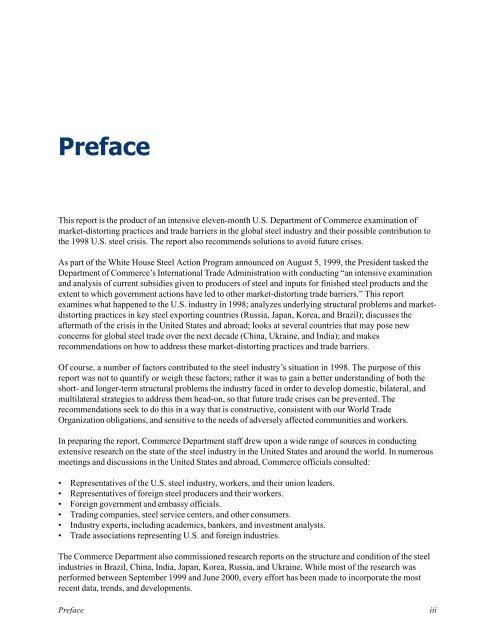Global Steel Trade; Structural Problems and Future Solutions
Global Steel Trade; Structural Problems and Future Solutions
Global Steel Trade; Structural Problems and Future Solutions
Create successful ePaper yourself
Turn your PDF publications into a flip-book with our unique Google optimized e-Paper software.
Preface<br />
This report is the product of an intensive eleven-month U.S. Department of Commerce examination of<br />
market-distorting practices <strong>and</strong> trade barriers in the global steel industry <strong>and</strong> their possible contribution to<br />
the 1998 U.S. steel crisis. The report also recommends solutions to avoid future crises.<br />
As part of the White House <strong>Steel</strong> Action Program announced on August 5, 1999, the President tasked the<br />
Department of Commerce’s International <strong>Trade</strong> Administration with conducting “an intensive examination<br />
<strong>and</strong> analysis of current subsidies given to producers of steel <strong>and</strong> inputs for finished steel products <strong>and</strong> the<br />
extent to which government actions have led to other market-distorting trade barriers.” This report<br />
examines what happened to the U.S. industry in 1998; analyzes underlying structural problems <strong>and</strong> marketdistorting<br />
practices in key steel exporting countries (Russia, Japan, Korea, <strong>and</strong> Brazil); discusses the<br />
aftermath of the crisis in the United States <strong>and</strong> abroad; looks at several countries that may pose new<br />
concerns for global steel trade over the next decade (China, Ukraine, <strong>and</strong> India); <strong>and</strong> makes<br />
recommendations on how to address these market-distorting practices <strong>and</strong> trade barriers.<br />
Of course, a number of factors contributed to the steel industry’s situation in 1998. The purpose of this<br />
report was not to quantify or weigh these factors; rather it was to gain a better underst<strong>and</strong>ing of both the<br />
short- <strong>and</strong> longer-term structural problems the industry faced in order to develop domestic, bilateral, <strong>and</strong><br />
multilateral strategies to address them head-on, so that future trade crises can be prevented. The<br />
recommendations seek to do this in a way that is constructive, consistent with our World <strong>Trade</strong><br />
Organization obligations, <strong>and</strong> sensitive to the needs of adversely affected communities <strong>and</strong> workers.<br />
In preparing the report, Commerce Department staff drew upon a wide range of sources in conducting<br />
extensive research on the state of the steel industry in the United States <strong>and</strong> around the world. In numerous<br />
meetings <strong>and</strong> discussions in the United States <strong>and</strong> abroad, Commerce officials consulted:<br />
• Representatives of the U.S. steel industry, workers, <strong>and</strong> their union leaders.<br />
• Representatives of foreign steel producers <strong>and</strong> their workers.<br />
• Foreign government <strong>and</strong> embassy officials.<br />
• Trading companies, steel service centers, <strong>and</strong> other consumers.<br />
• Industry experts, including academics, bankers, <strong>and</strong> investment analysts.<br />
• <strong>Trade</strong> associations representing U.S. <strong>and</strong> foreign industries.<br />
The Commerce Department also commissioned research reports on the structure <strong>and</strong> condition of the steel<br />
industries in Brazil, China, India, Japan, Korea, Russia, <strong>and</strong> Ukraine. While most of the research was<br />
performed between September 1999 <strong>and</strong> June 2000, every effort has been made to incorporate the most<br />
recent data, trends, <strong>and</strong> developments.<br />
Preface<br />
iii
















